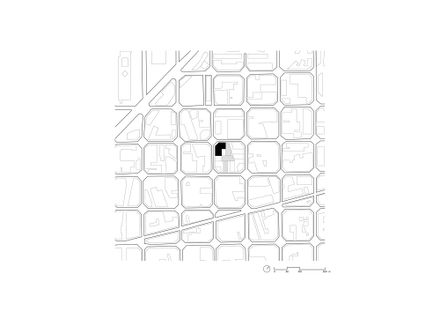
Simon SWITCH Building
ARCHITECTS
B720 Fermín Vázquez Arquitectos
CLIENT
Simon
MANUFACTURERS
Cosentino, Keim, Kingspan Insulated Panels, Dormakaba, Bandalux, Fsb Franz Schneider Brakel, Interface, Bernadi, Finsa, Iconico, Porcelanosa Grupo, Puigdellivol, Roca, Schindler , Schüco, Simon, Talleres Inox, Tecnocober
LEAD ARCHITECT
Fermín Vázquez
MEP
Jg Ingenieros
LIGHTING DESIGN
Mmas Lighting
DESIGN TEAM
Peco Mulet, Eduardo Varas, Pablo Garrido, Maialen Andiarena, Cristina Sánchez
OFFICES INTERIOR DESIGN
Katty Schiebeck Studio
SHOWROOM INTERIOR DESIGN
Estudi Antoni Arola, Estudi Jordi Tamayo
STRUCTURAL DESIGN
Bis Structures
ACOUSTICS
Coderch Acústica
LANDSCAPE
Local4
BUDGET
Dalmau + Morros
PROJECT MANAGEMENT
Martí Avilés
CONSTRUCTION
Joint Venture Nova Seu Simon (Calaf Constructora / Agefred)
SECURITY
Jordi Avilés
LOCATION
Barcelona, Spain
CATEGORY
Office Buildings, Showroom
English description provided by architect.
The rehabilitation of the old Simon factory to house the new Corporate Headquarters arose from the need to unify the more than 350 employees of the two previous offices under one roof.
The project is based on the idea of preserving the existing building from the second half of the 20th century, while introducing elements that highlight the new use, in the centre of Barcelona’s technological development.
The Headquarters is symbolically named SWITCH, the abbreviation for “Simon Worldwide Innovation Talent Community Hub”, and a nod to the electrical switch, one of the company’s trademark products.
The old building is essentially a concrete structure; a frame of porticoes, beams and slabs and a repetitive lattice on the façade.
Rehabilitating the building means, to a large extent, bringing this structure up to date.
The interventions include the careful repair of lesions, the selective demolition of areas to generate new communication cores and work areas and the demolition and reconstruction of parts in bad condition, following the original logic.
The traces of these interventions are not hidden, but can be seen as scars that become part of the building's history.
The project highlights the exterior grid, freeing it from its obsolete sills and closures. The new skin is configured by added elements, ‘technological cassettes’, inserted between the ribs.

An aluminum frame protects and regulates the perimeter of each opening, while the new glazed enclosure allows for high insulation and solar control performance.
The lightness and reflections of these elements contrast and enhance the materiality of the concrete. The reconversion contributes to the regeneration of Poble Nou, now transformed into the 22@ district.
The building becomes a link between the neighborhood’s industrial past and its future: What was once a closed-off factory becomes an extrovert technological hub.
The open showroom is located on the ground floor, while the upper floors house the workspaces, which open to the city through the façade’s new elements that are more than windows; their presence, depth, and play of reflections is complemented by the desire to serve as urban infrastructure, equipped for the installation of ephemeral elements, enhancing participation in events such as the "Llum" light festival.
SWITCH aims to be a benchmark for quality workspaces, and an example for the reuse of industrial buildings. It takes advantage of the original structure, introducing a new space configuration, high-performance facilities and equipment, and turning the roof, now equipped with solar panels, into a green space for the employees.
Intelligent management of the building optimizes its efficiency, incorporating digital tools for the shared use of workstations, meeting rooms, common spaces, or access to mobility. The rehabilitation prolongs the life of the obsolete building.
The contrast between the old and new elements highlights the structural system while providing an optimal level of natural light, solar protection, and thermal insulation.
The result is a building with a low environmental impact due to the reduction in the carbon footprint of existing materials with a long life cycle, the new energy efficiency, and its contribution to urban regeneration. The building has obtained a LEED Platinum certification.































